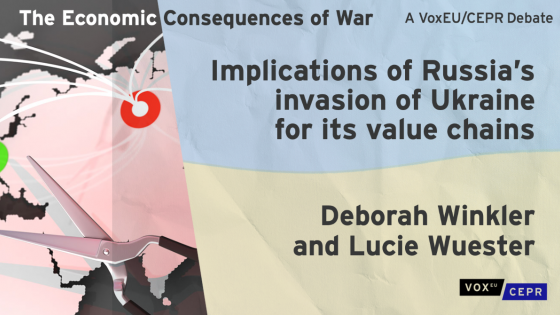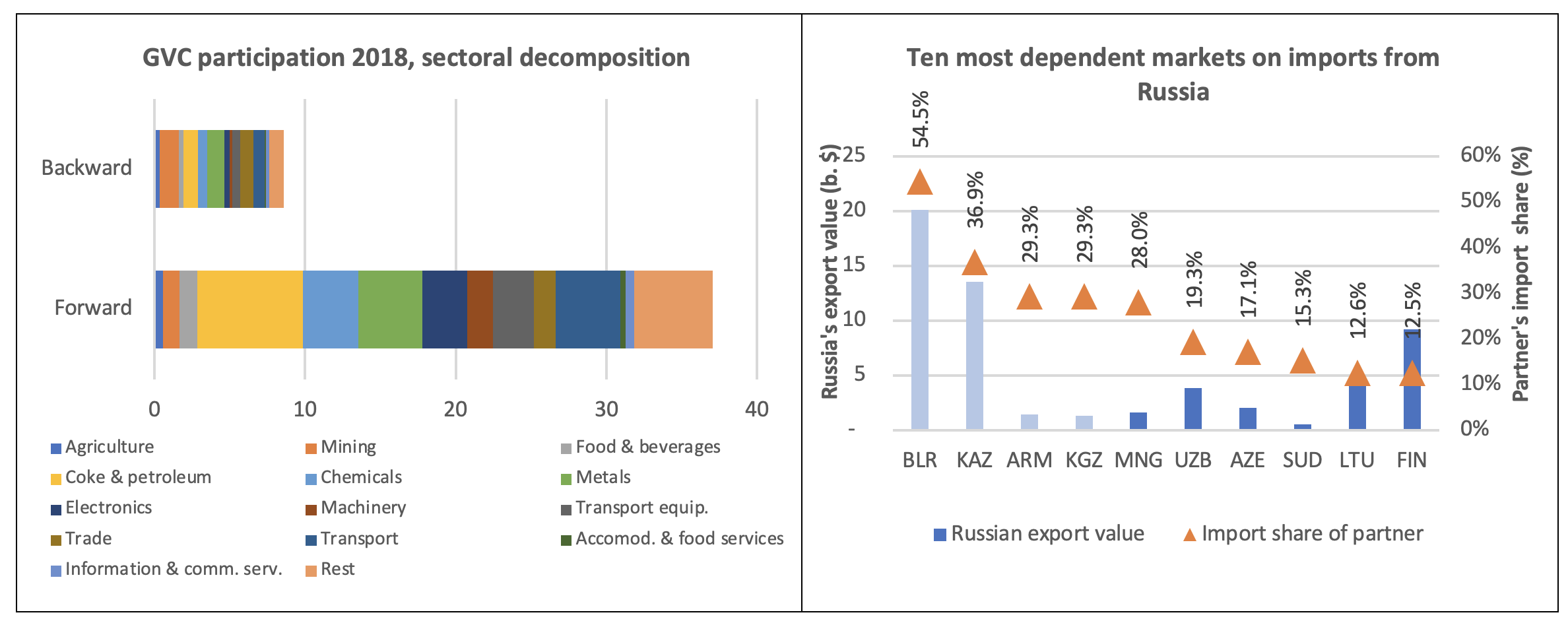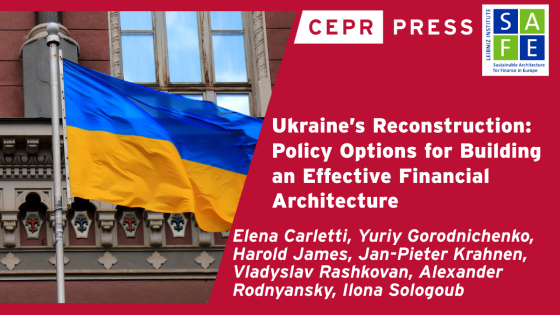Editors' note: This column is part of the Vox debate on the economic consequences of war.
The war in Ukraine is having far-reaching economic consequences for the country’s economy and human capital with spillovers of regional and global reach, notably through trade and finance links (Angris et al. 2022, Federle et al. 2022). Several researchers have begun to quantify the costs of trade restrictions vis-à-vis Russia for other countries (Langot et al. 2022, Chepeliev et al. 2022). In our recent analysis (Winkler et al. 2022), we study how Russia’s invasion of Ukraine affects global value chain (GVC) risks related to trade disruptions and highlight the vulnerability of countries reliant on Russia as an exporter of commodity inputs.
What is Russia’s role in global value chains?
Russia’s role as a major supplier of commodities places it at the foundation of a wide array of global production. Russia is especially important as an exporter of primary and intermediate goods and services used in other countries’ exports at an early stage of production. This is indicated by Russia’s position in global GVCs, which is marked by high forward GVC participation (or ‘upstreamness’). The commodities that drive this upstream link into GVCs are energy (coke and petroleum), metals, and chemicals, as well as transport and certain business services (Figure 1, left panel). By contrast, Russia is far less important as a ‘buyer’ in GVCs, relying less on imported inputs to produce its exports (backward GVC participation).
Disruptions of Russia’s exports will feed into GVCs via major global production hubs for trade and will especially affect regional economies that are highly dependent on these supplies. While virtually all GVCs are affected by rising energy prices, GVCs that are especially reliant on metals and fertilizer inputs from Russia for their export production include transport equipment, machinery, electronics, and agribusiness, as well as supporting services including transport and business services (Figure 2). The GVC production hubs of China (and to a lesser extent Japan and South Korea), Germany (and other Western European countries), and the US are among Russia’s largest trade partners, both as importers of Russian commodity inputs and as exporters of GVC goods. However, the countries that are most dependent on exports from Russia, and thus particularly vulnerable to such trade disruption, are neighbouring and regional economies (Figure 1, right panel).
Figure 1 Russia’s forward and backward GVC participation and ten most dependent markets on imports from Russia
Source: Own computations. Data: OECD-WTO TiVA 2021 release (left panel) and UN Comtrade (right panel).
Note: Forward GVC participation = Domestic value added embodied in third country exports (% of exports). Backward GVC participation = imported inputs in exports (% of exports). Mirror data for exports used. Bright blue bars = Eurasian Economic Union countries.
What are the GVC risk factors and channels?
As a major commodity exporter, disruptions of trade with Russia have a global impact through price hikes, notably of energy goods, which affect transportation costs and virtually all GVCs. Globally, supply constraints and price hikes are being felt, notably for wheat, corn, and vegetable oils (which has led several countries to restrict their own exports of such goods), fertilizers, metals, and energy commodities (Ruta et al. 2022). Logistics disruptions, inflated freight prices, and longer delays affect trade and transit flows between Russia and Europe but also between East Asia and Europe (Arvis et al. 2022).
Power relations also matter, with certain GVCs consisting of many competing suppliers globally (e.g. apparel), while in others global suppliers have large market power (e.g. semiconductors). For example, pig iron exports are dominated by three countries (Russia, Brazil, and Ukraine), together accounting for over three-quarters of global exports. Hence, replacing pig iron imports from Russia will be more difficult than products for which the global market is less concentrated.
In essence, while a country’s GVC risk depends largely on its direct trade links with Russia, GVCs reliant on products that have fewer substitutes will be affected more severely. The substitutability of inputs from Russia also depends on whether products are differentiated or homogeneous. Several of Russia’s key export products (e.g. rare metals) are difficult to replace in the short run, suggesting a severe impact on GVCs.
Which countries and value chains are most dependent?
Russia is a key exporter of several goods with few substitutes, including metals (with dependence on direct trade links highest for countries in the Europe and Central Asia, or ECA, region) and fertilizers (with high dependence of both regional and global markets), and also extends to services supporting those exports. Regionally close countries are particularly dependent on Russia as a trade partner. Examples of high regional dependence include imports of cereals and fertilizer from Russia, metals (nickel and iron and steel), wood products, and mechanical goods and vehicles (especially to the Eurasian Economic Union countries).
Figure 2 Russia as a seller, key sectors and products, and implications for GVCs and trade partners
Source: Own compilation.
Note: Based on analysis in Winkler et al. (2022).
A critical exporter of (rare) metals, several countries, especially in ECA, imported above 90% of certain iron and steel, aluminium, copper, nickel, and palladium goods from Russia. Over half of Russia’s metal exports over the period 2018–20 were of iron and steel. For instance, Denmark and Belgium depend on Russia for over 80% of their imports of semi-finished iron and non-alloy steel. Exports of unwrought aluminium largely reach the Commonwealth of Independent States, with shares above 90%. Both products are used in a range of manufacturing activities, including power, construction, consumer electronics, and transportation/vehicles.
Russia’s exports of fertilizers are important in both global and regional markets. Kazakhstan is the third largest buyer of Russia’s chemical exports and eight of the top ten most dependent markets on Russian chemicals imports are ECA countries. Almost half of Russia’s chemical exports consist of fertilizers. Belarus, Mongolia, and Moldova import over two-thirds of their fertilizers from Russia, while for Honduras and the Central African Republic the share is over half.
What is the role for policy?
The trade disruptions resulting from Russia’s invasion of Ukraine have revealed the vulnerabilities of firms and countries relying on concentrated suppliers for their imports. Russia’s upstream position as an exporter of energy, metals, chemicals, as well as transport and business services, most severely affects its regional neighbours as well as global trade partners with limited substitutes. New survey results show that German industrial firms would find it difficult or not economically viable to replace their inputs sourced from Russia, Ukraine, or Belarus in the short term.1 In the longer term, firms and government policies should focus on strengthening supply chain resilience to idiosyncratic shocks, for instance, by diversifying firms’ global supplier base or by becoming less dependent on production processes using conventional energy sources.
Authors’ note: The views expressed in this column are those of the authors and they do not necessarily represent the views of the World Bank Group.
References
Angris, N, S Djankov, P Goldberg and H Patrinos (2022), “The loss of human capital in Ukraine”, VoxEU.org, 27 April.
Arvis, J F, C Rastogi and D Saslavsky (2022), “Effects on Global Logistics and Connectivity”, in M Ruta (ed), The Impact of the War in Ukraine on Global Trade and Investment, The World Bank.
Chepeliev, M, Thomas Hertel and D van der Mensbrugghe (2022), “Cutting Russia’s fossil fuel exports: Short-term pain for long-term gain”, VoxEU.org, 9 March.
Federle, J, A Meier, G Müller and V Sehn (2022), “Economic spillovers from the war in Ukraine: The proximity penalty”, VoxEU.org, 18 April.
Langot, F, F Malherbet, R Norbiato and F Tripier (2022), “Strength in unity: The economic cost of trade restrictions on Russia”, VoxEU.org, 22 April.
Ruta, M, N Rocha and A Espitia (2022), “Effects on Food Trade,” in M Ruta (ed), The Impact of the War in Ukraine on Global Trade and Investment, The World Bank.
Winkler, D, L Wuester and D Knight (2022), “The effects of Russia’s global value chain participation,” in M Ruta (ed), The Impact of the War in Ukraine on Global Trade and Investment, The World Bank.
Endnotes
1 See https://www.ifo.de/en/node/69417





